Every Taiwanese child knows that the Dutch once came to Taiwan. They also know that they were driven away by Koxinga, a pirate turned patriot of Chinese-Japanese descent who was little more than an opportunist. It's a fact nonetheless that gives rise to warm feelings of nationalism at colonial powers getting their just deserts.
Scratch at this veneer of knowledge and most people know little more. And these days, beyond the ubiquitous presence of Philips household electronics, few people know there remains a significant Dutch presence on the island.
The reason the Dutch are here hasn't changed much. Their arrival in 1624 coincided with a conflict of interest between European powers that were positioning themselves to benefit from new Asian markets and from the sale of exotic commodities such as silk and spices. In 2000, western corporations still drool over the riches that Asian markets are expected to yield. The rules of the game may have become a bit more genteel, but fundamentally they remain the same. "The commercial spirit remains strong," says Paul Zeven, CEO of Philips Electronics, Taiwan, with a wry smile.
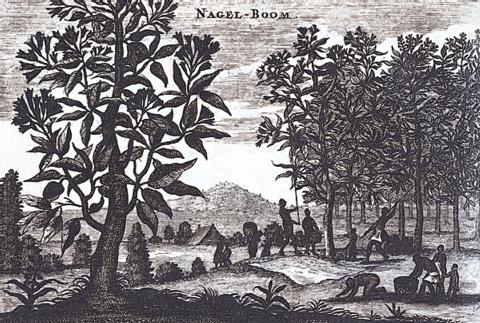
HISTORICAL PRINTS: COURTESY OF PAUL OVERMAAT
Zeven points out that Philips is now heavily invested in Taiwan's high-tech industry, in which it hopes to play a leading role. Yet despite its 30 years on the island and more than 10,000 staff, its presence is still relatively low-key. This was not always the case with the Dutch. While in Taiwan, they established two of the island's most imposing fortresses -- Fort Zeelandia in Tainan and Fort San Domingo in Tamsui.
Detailed records
But apart from ruins, what else did the Dutch leave behind? Cao Yung-ho (曹永和), a specialist on the Dutch maritime empire at Academia Sinica, says you only have to stand in the countryside and look around. The fields of rice and sugarcane, two of Taiwan's most important crops, are primarily due to Dutch exploration of the island's agriculture.
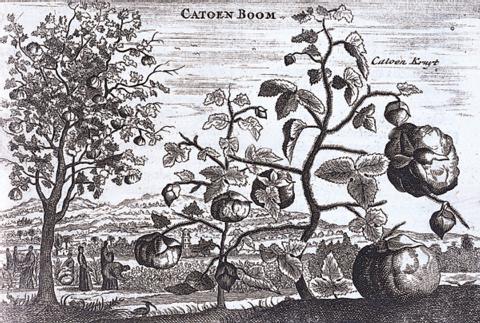
HISTORICAL PRINTS: COURTESY OF PAUL OVERMAAT
Another permanent and valuable contribution made by the Dutch was in providing some of the earliest detailed descriptions of life in Taiwan. The Dutch in Fort Zeelandia kept "day books," similar to a ship's log, which became invaluable historical documents in the study of Taiwan's early history.
For a taste of what the Dutch left behind, organizers of a recently opened exhibit titled "From Holland to Formosa" have created the newspaper-like Formosa Gazetteer, which offers extracts from historical records. Speaking of the unhealthy conditions that faced the Dutch, there is a matter-of-fact comment from 1649 that "many people in the service of the Dutch East India company died again this year in the southern villages on the island [from disease]." And for Oct. 25, 1645, records show that the "Chinese who are continuously inciting the natives have been subdued and chased away." These minor but often fatal incidents were the daily trials that comprised life and death for many Dutch living in Taiwan.
Based on other materials left by the Dutch, the Shung Ye Museum of Formosan Aborigines (順益台灣原住民博物館) has already published one of the earliest studies of Taiwan's aborigines. This is available in English with a Chinese version in preparation.
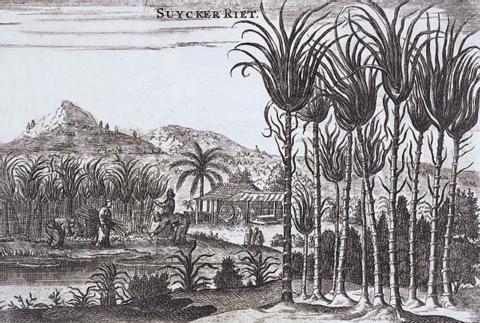
HISTORICAL PRINTS: COURTESY OF PAUL OVERMAAT
One of the most important results the preservation of these early materials is the reaffirmation of Taiwan's fundamentally multicultural roots. Everything about "From Holland to Formosa" seems designed to emphasize the cooperative nature of Taiwan's development. The venue itself is virtually a distillation of Taiwan's relationship with the west. The Dutch built Fort San Domingo, but the name is taken from an earlier Spanish stockade. The building was taken over by the British in 1860 and was not formally transferred to the ROC government until 1980.
Monumental venue
Holding the exhibition at this historic site has also inspired the Taipei Civil Affairs Department to alter its perceptions of what can be achieved with Taiwan's historic monuments. This is the first time that the venue has been loaned out for such a purpose, largely due to the efforts of Robin Ruizendaal, director of the Holland Festival and an organizer of the event.
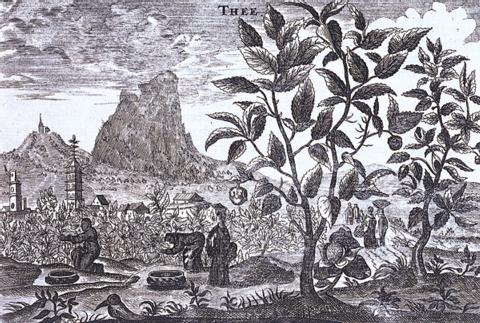
HISTORICAL PRINTS: COURTESY OF PAUL OVERMAAT
Moreover, during the exhibition, the grounds of Fort San Domingo will be opened at night for the first time (each Saturday). This has partially been made possible by Philips, who has provided lighting for inside and outside the fort. Lin Tsyr-ling (林慈玲), the newly appointed head of the Civil Affairs Department, is currently negotiating to have the external lighting loaned by Philips made into permanent fixtures to allow for regular night openings to make this heritage site a more dynamic tourism location.
The exhibition organizers have gone out of their way to make the event truly accessible, with a particular emphasis on young visitors. The exhibition is introduced by four cartoon children, who lead the way through an exploration of the Dutch and their lives and concerns in Taiwan. These children form part of a dynamic interface between the exhibits and the audience. After all, as Ruizendaal points out, "one map of Taiwan looks pretty much like another," unless you do something with the arrangement of objects to highlight points of interest.
As for the bigger picture, Seibe Schuur of the Netherlands Trade and Investment Office saw the project as an affirmation of the cooperation between Taiwan and the Netherlands. "Taiwan has always been at a crossroads of many cultures," he says. "There are lessons we can learn from the past that can be applied to the future."
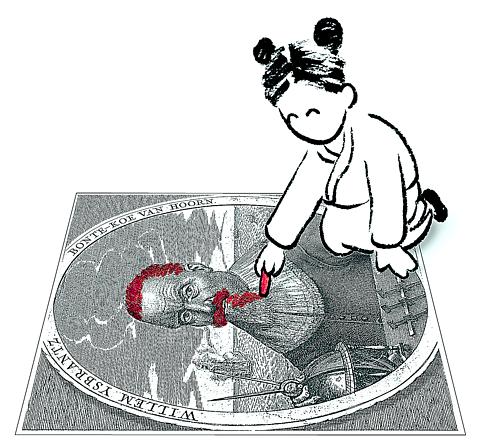
ILLUSTRATION: COURTESY OF NISAN WU
For your information:
What: From Formosa to Holland
An exhibition of 17th century Dutch culture

HISTORICAL PRINTS: COURTESY OF PAUL OVERMAAT
When: Until June 30
Where: Fort San Domingo (Hung Mao Cheng, 紅毛城), Tamsui

Most heroes are remembered for the battles they fought. Taiwan’s Black Bat Squadron is remembered for flying into Chinese airspace 838 times between 1953 and 1967, and for the 148 men whose sacrifice bought the intelligence that kept Taiwan secure. Two-thirds of the squadron died carrying out missions most people wouldn’t learn about for another 40 years. The squadron lost 15 aircraft and 148 crew members over those 14 years, making it the deadliest unit in Taiwan’s military history by casualty rate. They flew at night, often at low altitudes, straight into some of the most heavily defended airspace in Asia.

Many people in Taiwan first learned about universal basic income (UBI) — the idea that the government should provide regular, no-strings-attached payments to each citizen — in 2019. While seeking the Democratic nomination for the 2020 US presidential election, Andrew Yang, a politician of Taiwanese descent, said that, if elected, he’d institute a UBI of US$1,000 per month to “get the economic boot off of people’s throats, allowing them to lift their heads up, breathe, and get excited for the future.” His campaign petered out, but the concept of UBI hasn’t gone away. Throughout the industrialized world, there are fears that

Like much in the world today, theater has experienced major disruptions over the six years since COVID-19. The pandemic, the war in Ukraine and social media have created a new normal of geopolitical and information uncertainty, and the performing arts are not immune to these effects. “Ten years ago people wanted to come to the theater to engage with important issues, but now the Internet allows them to engage with those issues powerfully and immediately,” said Faith Tan, programming director of the Esplanade in Singapore, speaking last week in Japan. “One reaction to unpredictability has been a renewed emphasis on

Taiwan’s democracy is at risk. Be very alarmed. This is not a drill. The current constitutional crisis progressed slowly, then suddenly. Political tensions, partisan hostility and emotions are all running high right when cool heads and calm negotiation are most needed. Oxford defines brinkmanship as: “The art or practice of pursuing a dangerous policy to the limits of safety before stopping, especially in politics.” It says the term comes from a quote from a 1956 Cold War interview with then-American Secretary of State John Foster Dulles, when he said: ‘The ability to get to the verge without getting into the war is